ARCHAEOLOGICAL SITES IN OAXACA
Archaeological Sites in OAXACA
Map of Archaeological Sites in OAXACA
MONTE ALBAN
Monte Albán is the most important archaeological zone of the Oaxacan entity, of unique regional importance due to the religious, political and economic control that the Zapotec state exercised over the population of the Valley of Oaxaca for more than thirteen centuries. It has been named by UNESCO Cultural Heritage of Humanity together with the city of Oaxaca on December 11, 1987.
The heritage of the Zapotec world reaches us through the magnificent archaeological sites designed in the Valley of Oaxaca. Of these, the city of Monte Albán stands out for its enormous importance as an economic, political and religious hub (it was the first urban complex in Mesoamerica); by its extension, almost as big as the current capital of Oaxaca; and for its long life, which began around 500 BC and ended around 850 AD.
The city is surrounded by several mountains strategically located at the confluence of the arms that form the great Valley of Oaxaca. There are three groups that make up the site: Monte Albán, Atzompa and El Gallo, all configured by archaeological monuments on the peaks and by series of cultivation terraces on the slopes.
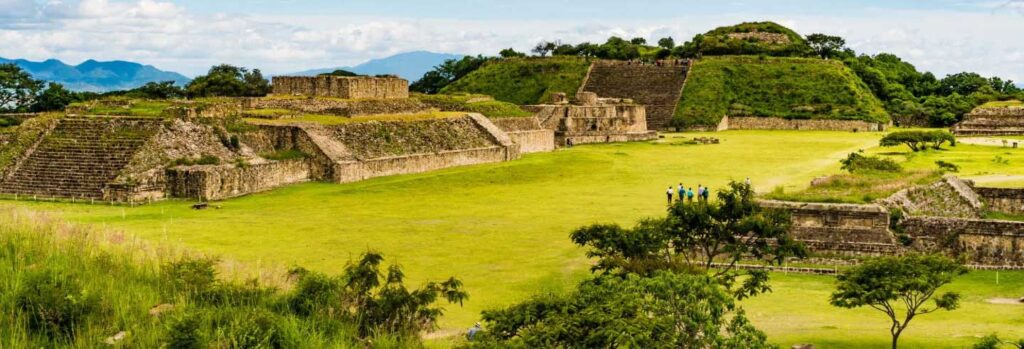
MITLA
The main ceremonial center after Monte Albán, the word Mitla or Mictlán is of Nahuatl origin and means “Place of the Dead” or “Underworld” in Zapotec. It is called “Lyobaa” which means “Burial place”, which already remained in Mexica in Mitlan, “place of the dead” and only Mitla has been Spanishized.
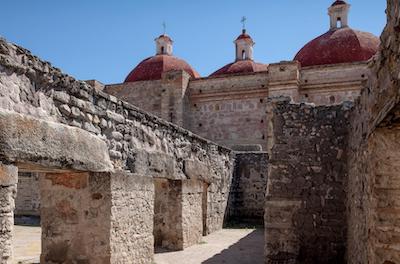
The archaeological complex and the current town are Zapotec, Mitla was inhabited from the classical period (100 to 650 AD) reaching its maximum growth and apogee in the post-classical period (750 to 1521 AD). The greatest attraction of the archaeological zone of Mitla is undoubtedly the varied ornamentation of its buildings, achieved through the system of frets that distinguishes it from those of the rest of the country.
There are five groups of constructions known as: Grupo del Sur, Grupo del Adobe, Grupo del Arroyo, Grupo de las Columnas and Grupo de la Iglesia. The first two are classified as ceremonial complexes, made up of mounds and central squares, the other three are classified as organized palaces with rooms around quadrangular courtyards.
Of the five the best preserved are the group of columns and the group of the Church. Group of columns: it is characterized by the use of monolithic columns from which its name is derived.
The great Hall of Columns has a rectangular plan. Through this hall you enter the main palace through a narrow door. Leaving the passageway we find ourselves in the patio of the frets, from where we will have access to each of the four rooms, decorated by three panels with mosaics of carved stone frets that form different geometric drawings on each band; the frets are made up of thousands of polished stone tablets, set together, without any mixture.
In the north and east buildings are the most beautiful tombs, where the Zapotec priests and kings were buried; in the first, in front of the staircase, there is the entrance to a cruciform tomb, with an antechamber; the ceiling has large monolithic stone lintels and the walls are decorated with panels and fretwork mosaics; the eastern one is characterized by a monolithic stone column that supports the roof.
YAGUL
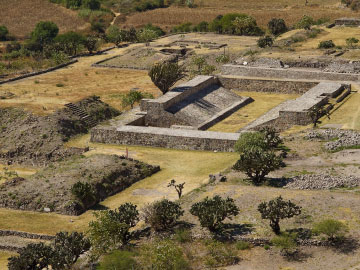
There is evidence of the occupation of Yagul from the time of Monte Albán l (500 years BC). It flourished as an urban center after the decline of Monte Albán (800 years AD). Later, after a short abandonment, Yagul re-emerged to become a city-state, in the Oaxaca valley, which prevailed until shortly before the arrival of the Spanish conquerors.
This important pre-Hispanic center, whose name in Zapotec “Ya-gule” means “Dry Tree or Palo” has among its monuments the largest ball court in the Oaxacan region and the second in Mesoamerica.
It flourished as an urban center after the decline of Monte Albán, between AD 750 and 950. Later, after a short abandonment, Yagul re-emerged to become a city-state, in the valley of Oaxaca, which prevailed until shortly before of the arrival of the Spanish conquerors.
This important pre-Hispanic center has among its monuments the largest ball court in the Oaxacan region and the second in Mesoamerica.
DAINZÚ
Dainzú is an archaeological site of the Zapotec culture, located in the eastern arm of the Central Valleys of Oaxaca, 19 kilometers south-east of the city of Oaxaca de Juárez, capital of the Mexican state of Oaxaca. It is an ancient contemporary city of Monte Albán whose flourishing predated the founding of the metropolis of Los Valles.
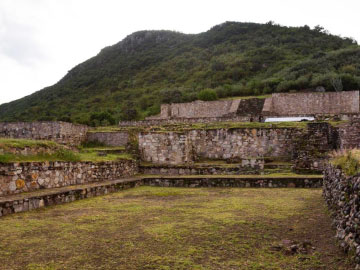
The architectural style of this site is important because it presents structures with unique characteristics that distinguish it from the others in the Oaxaca valley; These reflect a great artistic quality as in the lower platform of Building A, in which a gallery of bas-reliefs representing ball players were captured. During its urban period, Dainzú functioned as a second-rank community in economic, political and religious terms. The main occupation corresponds to the transition period called II-IIIa, from approximately 250 to 350 AD.
Dainzú was built recharged on the hill, apparently for aesthetic reasons its original entrance was on the west side of the river. It had a long sequence of occupations from 600 BC. until 1200 AD, although there is a possibility, as shown by archaeological materials, that the area was occupied before Monte Albán, the splendor of Dainzú, occurred between 600 BC. to 200 AD according to the data of the examinations.
The archaeological site of Dainzú is located in the vicinity of a tributary of the Salado River, in the Tlacolula valley, although there are some terraces and petroglyphs traced in the rocks of a nearby hill.
ATZOMPA
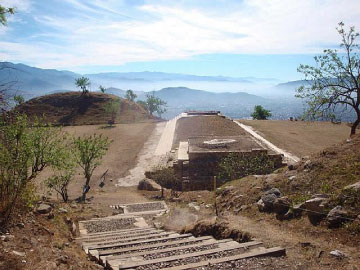
Atzompa, from Nahuatl, means ‘At the top of the water’ (atl ‘water’; tzontle ‘hair‘, ‘height‘ or ‘summit‘; and pan ‘in‘ or ‘on‘). It was one of the monumental complexes of Monte Albán. Its occupation goes from 650 to 900 AD. A peculiarity of this archaeological zone is the existence of three courts for the Ball Game very close to each other, one of them 45 meters long, which makes it the largest in the area, including Monte Albán.
The court has a niche in each of the corners, which could be used as a repository for the offerings. Due to the type of structures that are located in this area, it has been interpreted that it functioned as a place for specific rituals, as well as the residence of Zapotec priests and rulers, perhaps belonging to a specific lineage.
The archaeological zone is not officially open to the public, in such a way that it does not have any type of services or infrastructure to attend to the tourist visit, only with two custodians who provide general information about the site and help in case of being necessary.
ZAACHILA
The archaeological zone of Zaachila is located in the Villa de Zaachila, located in the Central Valleys of Oaxaca. It was founded by the Zapotecs, probably around the time when the construction of Monte Albán also began and the village of San José Mogote was flourishing.
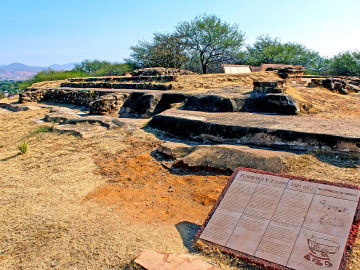
Although few remains of the ancient Zapotec site have survived to this day, they allow us to observe that Zaachila was a population that also played an important role during the Classic Period of the Zapotec culture. Witness of this are the two tombs that are part of the city, built in a similar way to those that were built during the heyday of the city of Monte Albán.
The main attraction of Zaachila is precisely the tombs discovered on the site. They were built under an old palace, and their style corresponds to the Postclassic of Mesoamerica. The walls of the tombs are adorned with stucco figures that represent creatures related to the world of the dead, according to Mesoamerican mythology, including the owl.
Other reliefs represent four characters of which two can be identified by their calendrical name. Inside the tombs, several polychrome pottery objects were found, which could have been produced by the Mixtecs or by the Zapotecs themselves under the influence of the former. Zaachila was founded around the 13th century after Christ. Understood in the post-classical period and after the decline of Monte Alban as a Zapotec city and capital.
LAMBITYECO
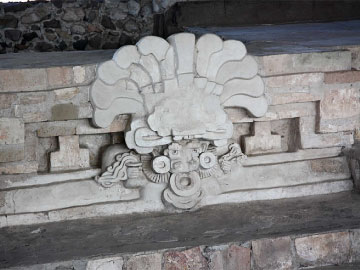
The remains of the houses and palaces explored are a small part of the city. The oldest palaces are those of the chiefs and priests.
SAN JOSÉ EL MOGOTE
San José El Mogote has existed for more than 3,500 years. It was possibly the first town to be founded in the village stage, and it was the largest of that time. It includes lands of Guadalupe Etla, the entire San José Mogote agency and lands of San Sebastián Etla.
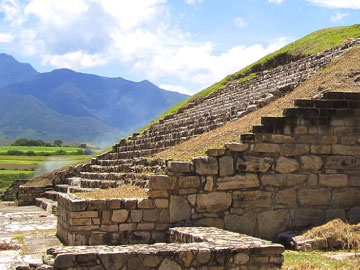
Here, for the first time, the predecessor cultures of the famous city of Monte Albán were defined. During the heyday of this center, San José Mogote served as the head of the Etla Valley. It also had its palace, its temples and its ball court. It was abandoned around 400 years before Christ. Shortly before the arrival of the Spaniards it was occupied again, as a small peasant town.
It is presumed that the founders of Monte Albán were also inhabitants of San José Mogote. Inscriptions found at the site document one of the oldest forms of writing in Mesoamerica, dating back to around 500 BC.
Archaeological remains show that the city was inhabited for at least 1000 years. The population went into decline towards the end of the Middle Preclassic, at the same time that Monte Albán took hegemony in the Central Valleys of Oaxaca. It was finally abandoned towards the end of the Late Preclassic.
BOCANA DEL RÍO COPALITA
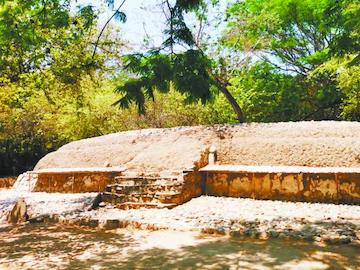
Copalita. Nahuatl term that means Place of Copal. This site is located on the western bank of the Copalita River, very close to the Bahías de Huatulco tourist development.
The first occupation of this pre-colonial settlement dates back to the Middle Pre-Classic period (600 BC). At this time, the construction of ceremonial platforms and residential terraces on the hills adjacent to the sea cliffs was manifested.
The classical period is the heyday of this city where there is already a ceremonial center that contains a ball court and a main building more than 20 meters high and which in turn contains, up to now, two tombs associated with the elite ruler.
GUIENGOLA
The Guiengola toponymic has two meanings, the first derived from the Zapotec language of the isthmus, composed of the words: guie, ‘stone’ and gola, ‘great‘ or old “Big Rock” and the second “great or old hill”.
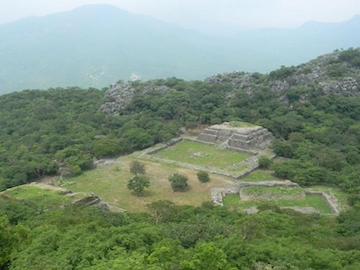
The city of Guiengola was built by the Zapotecs on a natural elevation, which together with the constructions made by its inhabitants, created a settlement that was difficult to invade. According to the ethnohistoric and archaeological data, this place was occupied by Mixes, Zoques, Huaves and Chontales, when they were attacked by other groups that came from the Altiplano and southern Mesoamerica.
It is believed that the city was still functioning at the time of Spanish contact. In addition to the fact that it was the scene of an important battle between the Zapotecs and the Mexicas, it contains notable architectural evidence.
The full extent of the city is unknown because little has been explored; Among the visible architectural ensembles, the Main Plaza is made up of 2 pyramidal bases and the ball court accompanied by other smaller constructions, these buildings were intended for public and ceremonial activities, and by the regular ones they were associated with the worship of divinities.
There are also other relevant sets such as the Palace that can be defined as the headquarters or place where the ruling or priestly class lived and is made up of a series of platforms, patios, rooms, warehouses, tombs and access stairs, and even wells of water or temazcales where the degree of elaboration and refinement of the architecture predominates. Its main chronology is Postclassic around the year 1350 AD. C.
CERRO DE LA CAMPANA (HUIJAZOO)
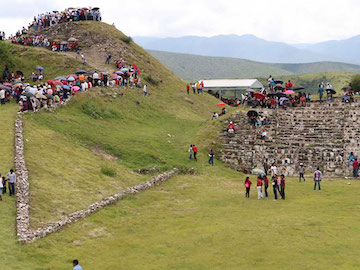
It is located in the extreme north of the Etla Valley in the Cerro de la Campana, just 30 km from the City of Oaxaca.
The chronology indicates that the founding of Huijazoo dates from 1450 BC, and the abandonment in 300 AD. The site was an important guiding center for the western part of the Etla Valley during the classical period (250 – 800 AD). It controlled all the trade that took place in the region.
Huijazoo, like Monte Albán, is built on a hill. The archaeological complex is made up of temples, palaces, a ball court, squares, shrines and tombs. In the highest part of the terrain there are three large platforms, of which two of them are aligned with the west-east orientation.
HUAMELULPAN
This Archaeological Zone sits on a hill known as Yucunindaba, which in Mixtec means “Cerro Volado” or “Cerro que Voló” (Hill that Flew). Huamelulpan is distinguished by its monumental architecture and sculpture, as well as by its calendrical inscriptions. Its occupation has been divided into three periods: Huamelulpan I, from 400 to 100 BC. C .; Huamelulpan II, from 100 a. C. to 200 d. C., in which it had a great demographic expansion, and Huamelulpan III, from 200 to 600 d. C., period in which its size decreases but the construction of buildings continues.
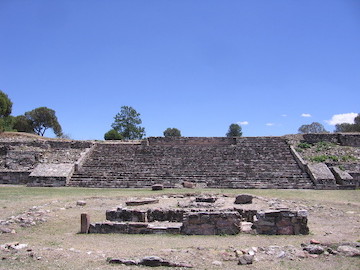
The city was built on a hill-hill system with terraces on the slopes of the aforementioned natural elevation. It was organized in monumental architectural ensembles separated into three main and two secondary nuclei. The site is divided into five architectural areas: Grupo del Cerro Volado, del Panteón, Iglesia Vieja, Poniente de la Iglesia and Grupo de la Iglesia.
Due to the predominance of several hills and hills that surround the environment, the various constructions were adapted to this type of terrain, building a system of terraces of simple houses with stone foundations where the common population lived, in other cases the public and ceremonial areas they are distinguished by having large stone platforms offset in a staggered manner delimiting open spaces. In the lower part is the building ball court related to a ritual that usually culminates in human sacrifice.
In the group to the West of the Church on the southern slope there are huge platforms whose corners were reinforced with rectangular stone blocks weighing several tons and where there are engravings with calendrical signs very similar to the Zapotec writing system observed in Monte Alban.
More Tourist Attractions in OAXACA
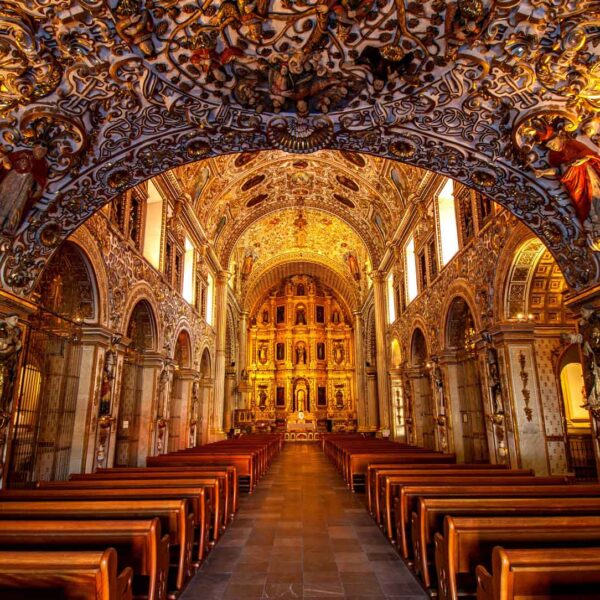
Santo Domingo Cultural Center
The Santo Domingo Cultural Center is a cultural complex that is located in what was one of the most important convents in the colony. It is a large convent in which the Museum of the Cultures of Oaxaca, the Fray Francisco de Burgoa Library and the Ethnobotanical Garden have been established. The Néstor Sánchez Public Newspaper Library is located in a building that is part of the complex but dates from the 19th century.… Read More
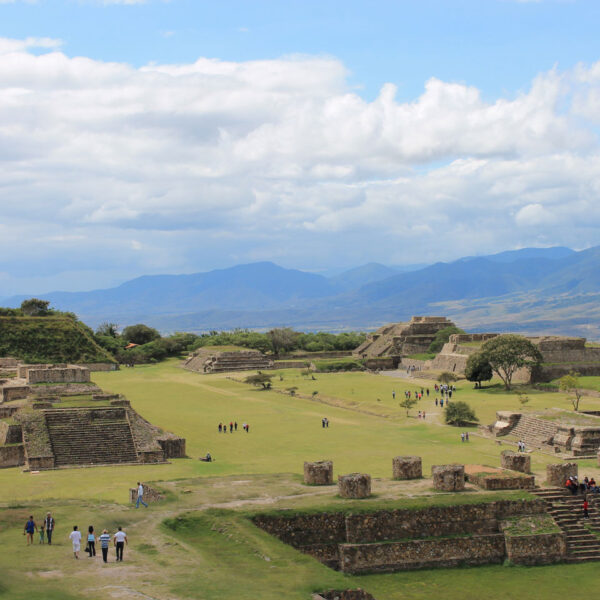
Monte Alban
Monte Alban is the most important archaeological zone of the Oaxacan entity, of unique regional importance due to the religious, political and economic control that the Zapotec state exercised over the population of the Valley of Oaxaca for more than thirteen centuries. It has been named by UNESCO Cultural Heritage of Humanity together with the city of Oaxaca on December 11, 1987. The heritage of the Zapotec world reaches us through the magnificent archaeological sites designed in the Valley of Oaxaca. Of these, the city of Monte Albán stands out for its enormous importance as an economic, political and religious hub (it was the first urban complex in Mesoamerica); by its extension, almost as big as the current capital of Oaxaca; and for its long life, started around 500 BC and concluded around 850 AD.… Read More
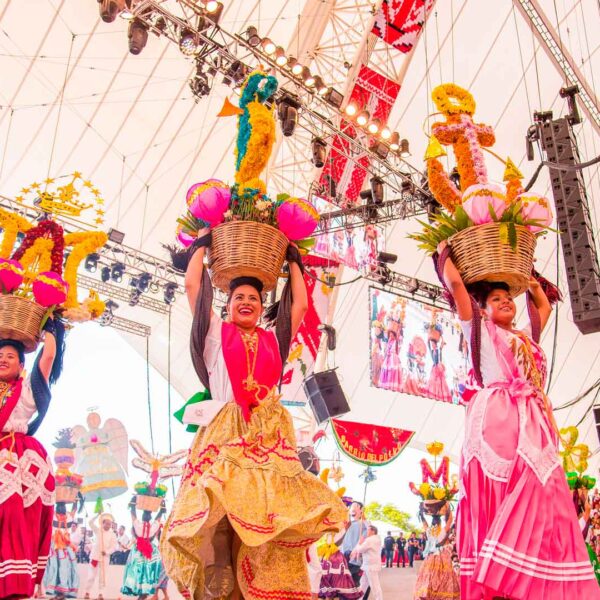
La Guelaguetza
The Guelaguetza is an ancient tradition with pre-Hispanic roots related to agricultural ceremonies of gratitude to the gods for the arrival of the rains and the lifting of the harvest at the end of July and is the largest festival in Oaxaca. La Guelaguetza is a celebration of gratitude for the arrival of the rains and the harvests, in which representatives from all regions of the state gather in the capital to share their culture through dances, crafts and food. La Guelaguetza is celebrated every year on the two Mondays after July 16, except when the first Monday is July 18, Benito Juárez’s death anniversary. Many types of dances also participate, such as the traditional Flor de Piña; where women usually dress in Huipiles representing the different regions of the state, as well as with their pineapple on their shoulders, they comb their hair with beautiful long braids accompanied by their ribbons and can not missing her accessories that is, bracelets, necklaces and earrings of precious colors and her beautiful makeup.… Read More

Mezcal
Mezcal is a rich, handcrafted flavored drink that requires considerable attention to be produced. Mezcal is normally served with white salt or worm salt (salt mixed with a cooked larva and ground chili), lemon or orange. Mezcal production today remains more or less as it was when the Spanish arrived hundreds of years ago. Each “recipe” is transmitted from generation to generation within the families that care about its production; Because each family has its own approach to mezcal production, there are an enormous number of different flavors. It is also in this way that the rich diversity of flavors and traditions are preserved for all to enjoy.… Read More
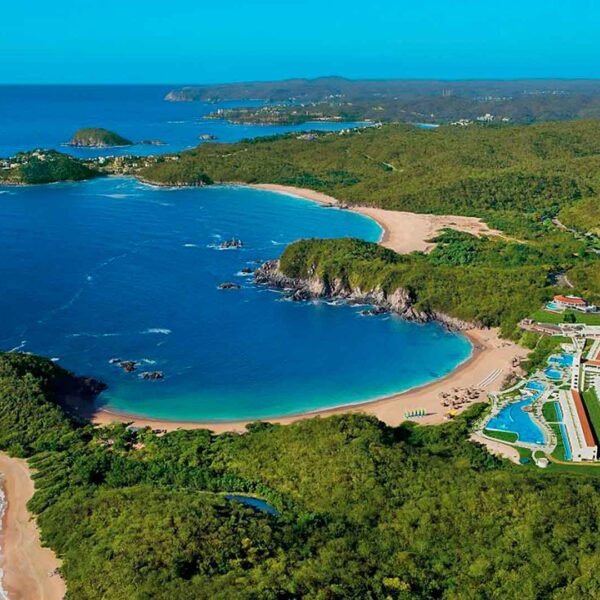
Beaches in Oaxaca
The beaches of the coast of the state of Oaxaca are among the most beautiful and complete in Mexico, thanks to a developing tourist infrastructure and the rich gastronomy of the Pacific. Along the 533 kilometers of coastline, the beaches of Oaxaca offer a wide variety of activities for lovers of water sports: snorkeling, diving, sport fishing, surfing, among others… there is something for everyone!… Read More
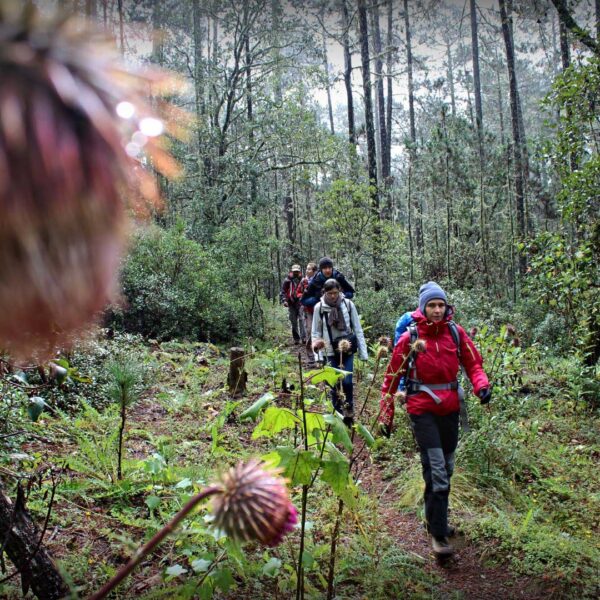
Ecotourism and Adventure in Oaxaca
Oaxaca, located in the southeast of Mexico, is an example of a singular miscegenation that even in the midst of modernity never forgets its origins. In its varied geography, it brings together not only a vast biodiversity, considered among the largest in the world, but also insurmountable cultural and ethnic riches, and the most different and beautiful natural settings. An ideal space for Alternative Tourism, Oaxaca offers activities such as walking, mountain biking, rappelling, climbing, zip-lining, horseback riding, observation of flora and fauna and more, in close contact with nature. The visitor can also witness the various aspects of local life, savor the gastronomy and enjoy the warmth of its people, as well as an offer of accommodation in hotels, ecotourism cabins, local houses or excellent camping areas.… Read More
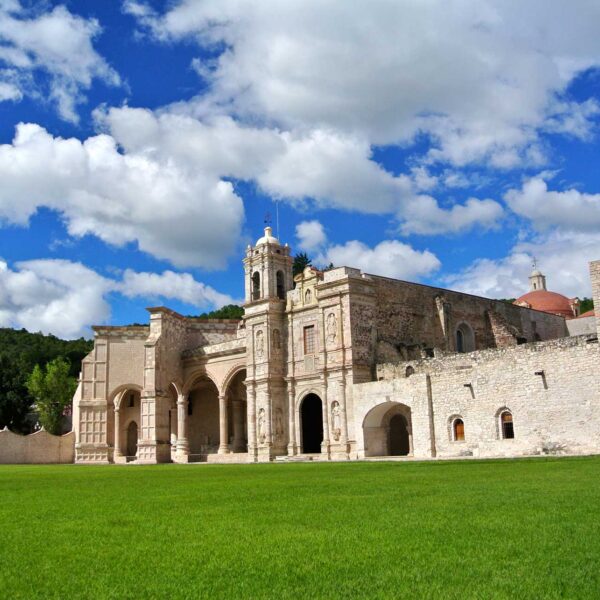
Magical Towns in Oaxaca
In Oaxaca we are proud to have 5 communities that have been awarded the title of Magical Towns of Mexico, a Magical Town is a town that has symbolic attributes, legends, history, transcendent events, everyday life, in short magic that they emanate in each of their socio-cultural manifestations, and that today mean a great opportunity for tourist use. The Magic Towns Program contributes to revalue a group of populations in the country that have always been in the collective imagination of the nation as a whole and that represent fresh and different alternatives for national and foreign visitors.… Read More
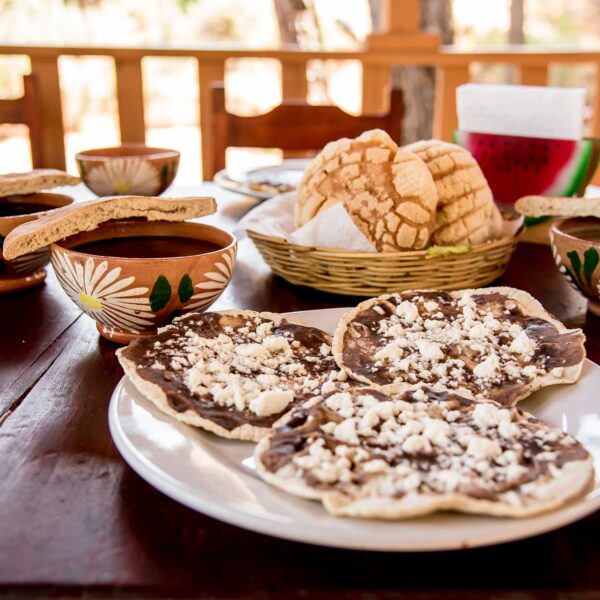
Gastronomy of Oaxaca
The Oaxacan gastronomy takes you on an amazing journey into one of the most outstanding and colorful cuisines in the world. Oaxacan food is among the most varied and delicious in Mexico, UNESCO has declared it Humanity’s Cultural Patrimony. Oaxaca’s gastronomy incorporates elements of pre-Hispanic cuisine, and lively imagination has created combinations that amaze by the color, the aromas and the flavors.
The list of dishes that characterize this cuisine is endless, however, we can mention: Oaxacan Mole in its 7 varieties depending on the type of chili used, Chapulines, (dry roasted, spiced grasshoppers), tlayudas (large tortilla spread with the remaining of the lard and beans), maguey worm sauce, chiles rellenos (stuffed chilies), and of course the famous Oaxacan tamales in banana leaves. Oaxaca cheese is a soft white string cheese, which is similar to mozzarella. It is sold in “ropes” which are wound onto themselves into balls, and eaten cold or lightly melted on quesadillas is considered among the best in the world.… Read More
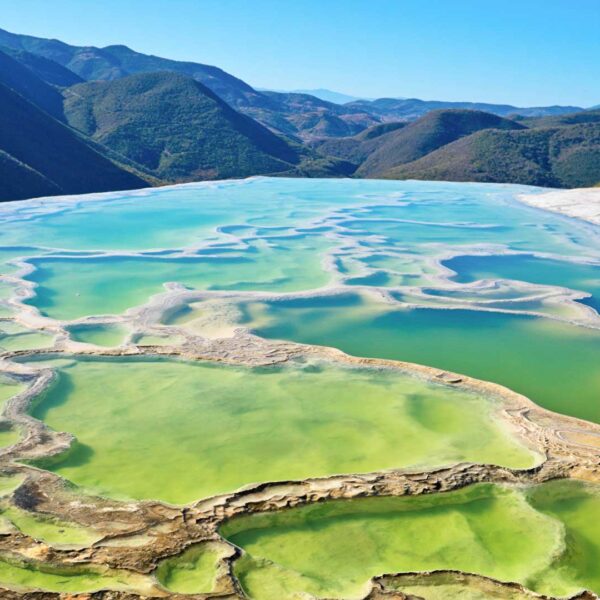
Oaxaca City Surroundings
Oaxaca is a destination that offers a great variety of attractions and tourist charms which leave anyone surprised. When arriving in the city of Oaxaca, the most common is to visit the historic center, the Santo Domingo Temple, the Macedonio Tourist Walk, the gastronomic delights in the Benito Juárez market, the Basilica de la Soledad, among other attractions. And one of the places that you cannot miss is the Monte Alban archaeological zone, which is approximately 30 minutes by car from the historic center. However, there are other places that are also worth knowing and are in the surroundings of the city. For this reason we recommend the following tourist routes.… Read More
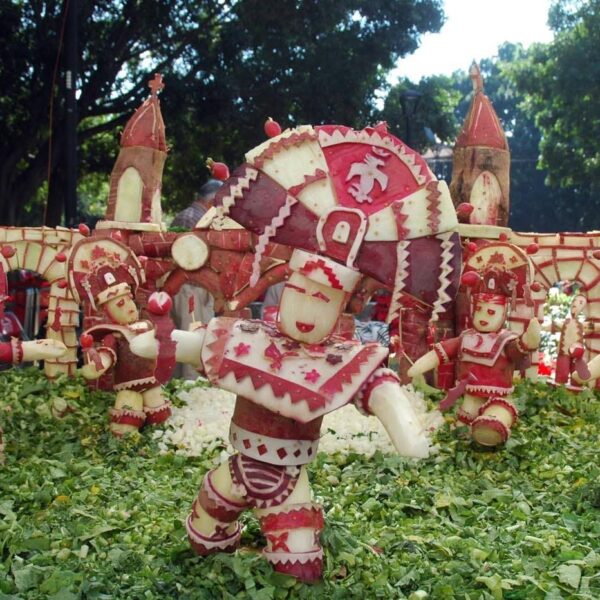
Traditions of Oaxaca
In the state of Oaxaca there are many customs and traditions throughout the year, and within the state, said that they have the same purpose of celebration but with different things, in fact from one region to another or even more from one town to another, the Customs vary for perhaps details but that is what makes them authentic. All the holidays are celebrated, the profane and the religious ones. The festival calendar is extensive due to the diversity of ethnic groups, which they still conserve. Oaxaca has a combination in its traditions of the culture of the ancestors and the current culture, a state that does not lose its customs, adapts them to new times and needs.… Read More
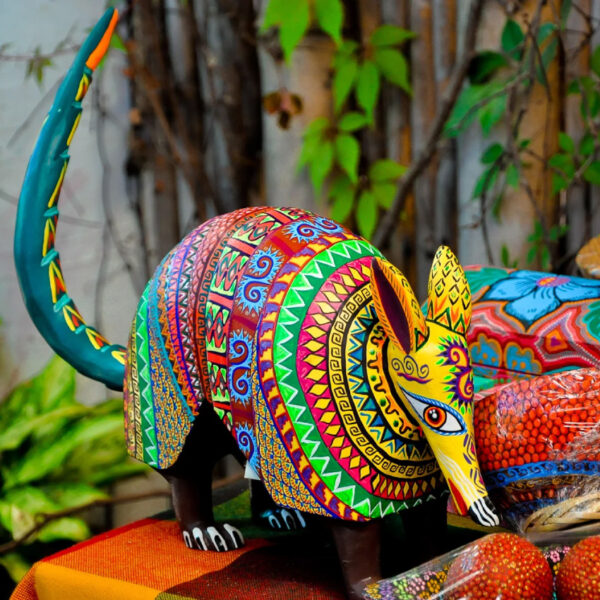
Handicrafts from Oaxaca
Handicrafts from Oaxaca are a great tradition and they offer a diversity that denotes the artistic richness and imagination of its people. The talented artisans of Oaxaca make beautiful pieces of clay, textiles, wood, metal, skins and other materials, forming a rich and varied folk art in both decorative and useful items.… Read More
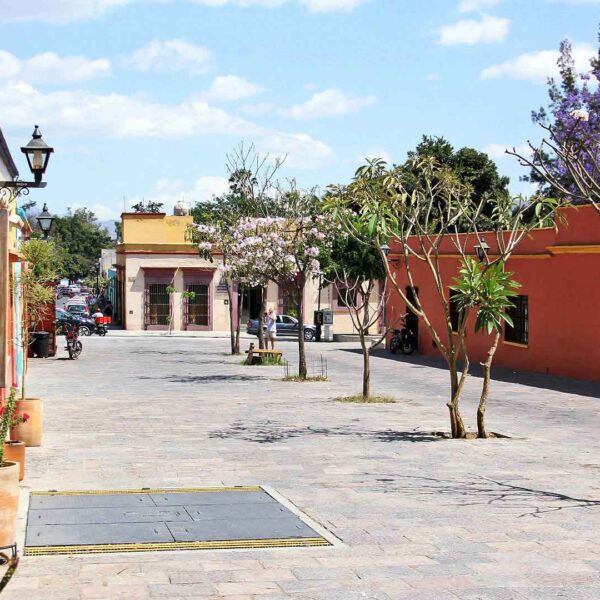
Oaxaca City
Oaxaca is the most diverse state in Mexico. It has peaks that reach more than 3,000 meters high, caverns that are among the deepest in the world, virgin beaches, secluded forests, and sunlit valleys. Oaxaca is rich in traditions and customs and has the largest ethnic population found in Mexico.
The City of Oaxaca, the state capital, is famous for its architecture and for its rich cultural traditions. Oaxaca is also graced by a splendid and varied cuisine and spring-like weather year round. UNESCO declared the city a Cultural Heritage Site.… Read More
Guided Tours in OAXACA
Flights & Hotels in OAXACA
More Tourist Attractions in MEXICO

Archaeological Sites
The Archaeological Zones are the cultural past of every Mexican. You will be amazed at the ambient, nature and the environment that surrounds them. Climbing to the top or being around it will take us back in time to admire every detail. México is a country of culture and traditions, many of which we have inherited from the pre-Hispanic inhabitants of this vast territory, although it is true that there were more settlements in the central and southern part of the country, it is also possible to find some archaeological remains in the north.
… Read More

Magical Towns
A Magical Town is a place with symbols and legends, towns with history that in many cases have been the scene of transcendent events for our country, they are places that show the national identity in each of its corners, with a magic that emanates from its attractions ; visiting them is an opportunity to discover the charm of Mexico. The Magical Towns Program contributes to revalue a set of populations in the country that have always been in the collective imagination of the nation and that represent fresh and varied alternatives for national and foreign visitors. A town that through time and in the face of modernity, has conserved, valued and defended its historical, cultural and natural heritage; and manifests it in various expressions through its tangible and intangible heritage. A Magical Town is a town that has unique, symbolic attributes, authentic stories, transcendent events, everyday life, which means a great opportunity for tourist use, taking into account the motivations and needs of travelers.… Read More

Traditions in Mexico
It is practically impossible to make a meticulous, and above all, accurate selection of the places to visit in Mexico. Each place that our country houses is unique and beautiful in its own way. Mexico, with its nearly 2 million km², has a large number of scenarios to offer, as well as endless activities to do. Do not lose your way and enter the places to visit in Mexico. In Mexico, apart from the beaches and its famous archaeological sites, there are many other really interesting sites and activities that you should know. In the surroundings of the main cities you will find places full of culture and tradition, where you can spend relaxing, interesting and fun vacations. On your trip through Mexico you cannot stop obtaining souvenirs, the crafts that are made here are of the highest quality and recognized worldwide. A shopping tour cannot be missed.… Read More

States Of Mexico
Mexico has an incredible diversity of landscapes, where the beauty of its beaches, internationally recognized, stands out. In its vast territory of coasts, there are beaches of unparalleled beauty, and colorful landscapes. A large network of first-class hotels and tourist services is available to visitors to these beaches. Mexico is also mystical places, dotted with archaeological testimonies inherited from its original inhabitants. Monuments made by the Mayas, Aztecs and Toltecs are located in magical landscapes, like lighthouses in an ocean of natural beauty. They offer visitors buildings that tell their history, and museums that collect their cultural heritage. And that keep alive ancestral traditions, in ceremonies and festivals, where you can enjoy cultural activities and entertainment.… Read More

Beaches
On the Beaches of Mexico you can immerse yourself in the intense blue ocean of the Pacific bays, sunbathe on the shore of the warm and transparent waves of the Caribbean Sea in Quintana Roo or even rest on the beautiful coasts of the Gulf of Mexico. Mexican beaches hide wonderful secrets for the traveler. By visiting them, in addition to enjoying the excellent climate and water activities, you can discover splendid archaeological sites and interesting colonial cities without traveling long distances.… Read More

Ecotourism and Adventure
Mexico is one of the best countries for Ecotourism as it has a great variety of flora and fauna, as well as a large number of refuges for extraordinary species. You can enjoy recreational activities of appreciation and knowledge of nature through contact with it, such as: stargazing, observation of natural attractions, wildlife and bird watching. Throughout México there are more than 176 protected natural areas, 5 of them considered by UNESCO as Natural Heritage of Humanity. Just for this and much more, we believe that Mexico is a Paradise for Ecotourism.… Read More

Capital Cities
Folklore, gastronomy, literary culture, art and exhibitions, is what you will find in the capitals of the states of Mexico. To the north, colonial Mexico, Puebla, Guadalajara, Guanajuato, the Sonoran desert and the California peninsula. To the east Veracruz and the gulf. To the west Acapulco, Oaxaca and Tuxtla Gutiérrez. And to the south the Riviera Maya and the pyramids of Chichén-Itzá, Tulúm and Cobá in Yucatán, Palenque in Chiapas, the cenotes, and the Central American jungles.… Read More

Gastronomy
The Gastronomy of Mexico has a great diversity of typical dishes, which is why it was recognized by UNESCO as Intangible Heritage of Humanity. The basic and representative ingredients of Mexican dishes are: corn, coriander, chili, beans, piloncillo, nopal and tomato. Mexican cuisine is also characterized by its sauces, which serve as an accompaniment to traditional dishes, prepared based on spices.… Read More

